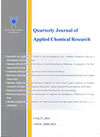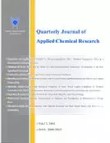فهرست مطالب

Journal of Applied Chemical Research
Volume:13 Issue: 1, Winter 2019
- تاریخ انتشار: 1397/12/12
- تعداد عناوین: 8
-
-
Pages 8-23In this research the magnetite nanoparticles supported silica sulfonic acid (Fe3O4@SiO2@OSO3H) was used as a green and efficient catalyst for the preparation of octahydroquinazolinone derivatives as biologically active heterocyclic compounds. This procedure avoids hazardous reagents, solvents, catalyst and can be an eco-friendly alternative to the existing methods. The one-pot three-component reaction of aldehydes, dimedone and urea or thiourea has several advantages such as: simple procedure, eco-friendly approach, excellent yields, short reaction times, little catalyst loading, simple purification and facile catalyst separation. In addition, the synthesis and application of Fe3O4@SiO2@OSO3H nanocomposite as a robust and recoverable heterogeneous nanocatalyst is described. Fe3O4 nanoparticles encapsulated-silica particles bearing sulfonic acid were readily recovered using an external magnet and could be reused several times without significant loss of its reactivity. The catalyst was fully characterized by different spectroscopic techniques including VSM, FT-IR, SEM, XRD, EDX and TEM analysis.Keywords: Fe3O4@SiO2@OSO3H, Nanoparticles, Multi-component reaction, Core–shell, Octahydroquinazolinone
-
Pages 24-35In the present study, a new biosensor for 5-Fluorouracil was described using modified gold electrode and Fast Fourier transform square wave voltammetry (FFT SWV). Calf thymus DNA immobilization was on a gold electrode decorated with polyaniline and gold nanoparticles. The electrochemical characteristics of the electrodes were investigated by cyclic voltammetry, and electrochemical impedance spectroscopy. After interaction DNA with the analyte, a dramatic decline in [Fe(CN)6]/[Fe(CN)6]]3-/4- signal was observed which could be used as the signal. The important parameters of the detection system, such as, pH were optimized. The linear dynamic range of the biosensor was1×10-9 to 1×10-6 M (r2=0.996) limits of detection of 2.5×10−10 M. In addition to the wide linear range response, the proposed method demonstrated acceptable sensitivity, repeatability and long-term stability. Future experiments could be performed to examine several other effective factors so as to decrease the influence of the environment and investigate its application to FFTSWV detection.Keywords: Electrochemical DNA biosensor, 5-Fluorouracil, Gold electrode modification, Fast Fourier transform voltammetry
-
Pages 36-44In this research, one-pot three-component synthesis of 3,4-dihydropyrimidin-2-(1H)-ones have been developed using Biginelli reaction from the interaction between ethyl/methyl acetoacetate, aromatic aldehydes, and urea/thiourea in the presence of 4-sulfobenzoic acid as a new, effective, inexpensive, and available bronsted acid. Avoidance of toxic and dangerous solvents, easy isolation of products without the need of column chromatography, high yields, and short reaction time are some important features of the present method.Keywords: 3, 4-dihydropyrimidin-2-(1H)-one, 4-sulfobenzoic acid, one-pot, solvent-free
-
Pages 45-56A convenient and highly efficient procedure for the synthesis of 3,4-dihydropyrimidin-2-(1H)- one/thione derivatives via one-pot three-component Biginelli condensation of aryl aldehydes,urea/thiourea and ethyl/methyl acetoacetate in the presence of Zn(SO4)2.7H2Oas an efficient, readily and inexpensive catalyst under solvent-free conditions have been studied. This protocol has advantages such as readily available and non-toxic catalyst, short reaction times, good to high yields, solvent-free conditions, facile reaction profiles, high atom-economy and simple work-up.Keywords: Zn(SO4)2.7H2O, 3-4-dihydropyrimidin-2-(1H)-one-thione derivatives, low-cost, nontoxic catalyst, Solvent-free conditions
-
Antimicrobial Modified-Tragacanth Gum/Acrylic Acid Hydrogels for the Controlled Release of QuercetinPages 57-71In this study, new antimicrobial hydrogels were prepared via reaction of functionalized-tragacanth gum (TG) biopolymer by quaternary ammonium functionalization of TG (QTG) with acrylic acid (AA). Characterization of the QTG hydrogels (QTG-AA) was carried out by FTIR, thermogravimetric analysis (TGA), and 1H NMR. Dynamic mechanical analysis, (DMA) was conducted to characterize the mechanical behavior of hydrogels. Swelling behavior of the QTG hydrogels exhibited dependence on the pH, immersion time, medium, and temperature. Loading and in-vitro drug release from the final hydrogels were studied by using quercetin as a model drug. The results exhibited the pH-sensitivity of the hydrogels for drug delivery. The antimicrobial effect of the prepared hydrogels was investigated against some standard microorganisms and the results demonstrated that the hydrogels possess good antimicrobial activity against gram-positive and gram-negative bacteria as well as a fungus.Keywords: Release profile, Antibacterial, Drug release, Non-Fickian diffusion mechanism
-
Pages 72-84A simple andefficient hollow fiber-based method,viz magnetic solvent bar liquid-phase microextraction (MSB-LPME) combined with gas chromatography-flame ionization detection (GCFID) has been successfully developed for the trace determination of mononitrotoluenes (MNTs) in natural water samples. The analytes were extracted from sample solution to the organic solvent immobilized in a fiber. Following the extraction, the analyte-adsorbed magnetic solvent bar can be easily isolated from the sample solution by a magnet which could significantlyfacilitate the operation as well asreducing the total pretreatment time. The bar was mainly eluted with acetonitrile, evaporated to dryness while the residue was dissolved in toluene and finally injected into GC-FID. At first, a series of parameters influencing microextraction performance were systematically investigated and optimized. The values of the detection limit were in the range of 0.05-0.08 μg L-1 and the RSD% for the analysis of 50.0μg L-1 of the analytes was below than 5.8% (n = 6). An acceptable linearity (0.996 ≥ r2 ≥ 0.995) and a broad linear range (0.2-200 μg L-1) were achieved. The method was eventually employed for the preconcentration and determination of the MNTs in environmental water samples and acceptable results were reached.Keywords: Gas chromatography-flame ionization detection, Magnetic solvent barliquid-phase microextraction, Mononitrotoluenes, Natural water samples
-
Pages 85-96Microwave assisted reactions have gained considerable attention, due to versatility and reduction of solvent and reaction time. The reaction of a nano-coconut shell and boron tri-fluoride in diethyl ether solvent resulted in preparation of nano-coconut shell-BF3 as a catalyst. The nano-coconut shell-BF3 catalyst has been characterized by fourier transform infrared spectroscopy (FT-IR), field emission scanning electron microscopy (FESEM) and transmission electron microscopy (TEM). Nano-coconut shell-BF3 has been applied as a new heterogeneous catalyst for synthesis of 4Hchromene derivatives from the simple one-pot reaction between aryl aldehydes, cyclic 1,3-diketone and, malononitrile under microwave reaction. Cleanliness, simple methodology, short time, and excellent yields of products are some advantages of this method.Keywords: 4H-chrmoene, Boron trifluoride, Nano-catalyst, Multi-component reaction, Coconut shell
-
Pages 97-105
The invisible inks have many applications, including the use of banknote printing, code load, security documents and much of its application in the exchange of security information. Photoluminescence properties of lanthanide compounds that attracted the attention of many scholars in recent decades are one of the important factors in drying and fluidity of the ink. The solvent evaporation rate has a special importance in the formulation of resin systems. The solvent evaporation rate is often expressed in compare with a standard solvent evaporation rate, such as normal butylated acetate or ethyl ether. The mixing of some solvents may be used due to the formation of an azeotrope and the more rate of evaporation. In the formulation of the inks, the use of the weight ratio compared with the volume relationship has this advantage, which requires less mathematical calculations and operations, especially that this score is useful during the early stages of formulation. In this research, from 160 materials that were used, 11 items played a fundamental role, which were selected based on their formulation planned. The purpose of this research was to produce invisible ink.For this purpose, the relevant complexes were prepared, designed and the composition of the percentage of invisible ink was optimized. Eventually, obtainedresults were evaluated.
Keywords: Evaporation Rate, Invisible Inks, Butyl Acetate


